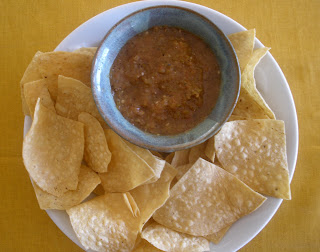

As it was
two years ago, the corn was late. I don’t know about you, but I think it’s a little dry. It’s good, mind, but not iconic. When you go to scrape the milk from the cob after cutting off the fresh corn, there’s very little there. As I said, dry.
So the corn is not as good as I would prefer for fritters or other things where I like all that corny milkiness; I made some corn pancakes, and they were good, but not as
infused as they might be. Still, the cobs boiled up into a pretty creditable
corn stock, though I did cook them a little longer than usual to extract their flavor.
This week, following on the record-breaking heat that the East Coast and much of the country has experienced, has been rather cool—more like a nice June than a peak-summer July. I don’t know if it is a sign of a shift toward the end of a short summer. I did notice that the Joe Pye-Weed has appeared at the side of the road, always
an omen. There was one night when I wished I had some socks. Perhaps I am just talking myself into end-of-Little-Compton-summer to ease myself out, heading as we are toward the start of another academic year. All good things. . . .

While the corn was late, the potatoes were, I think, a tad early. How I love them. I culled all the tiny ones to make
cocktail potatoes (can I reiterate how much I love these and how perfect they are with a crisp white or champagne?), and have been making lots of
potato salad as well. A few extras are just enough to combine with the stock to make a chowder.
Corn Chowder
This is a simple, straightforward soup. I like my chowder thin, not thick and pasty.
Serves 6.
3 oz
salt pork, chopped, or 2-3 T lard or butter
1 small onion, chopped fine
3 medium red skin brand new potatoes, diced
2 T finely minced celery
2 medium cloves garlic, minced
Salt and freshly ground pepper
1 qt corn stock (follow instructions
here)
2 ears
corn 1 ½ c
heavy cream 1 c whole milk
1 medium-large ripe tomato, seeded and chopped
½ tea Aleppo pepper (optional)
Dozen or so Ritz crackers, ground with a rolling pin

Chopped fresh cilantro or basil for garnish
Cut the salt pork into small dice and cook over medium heat to render the fat. Turn the heat up a little and add the onion, sautéing until translucent, then add the potatoes and cook, stirring from time to time, until they and the onions begin to brown. Add the celery and garlic, tossing for a few minutes; add additional fat if needed (lard or butter) to keep it from sticking. Season with salt and pepper.
Cut the corn from the cobs and add to the potato-onion mixture. Add the stock, cover, and bring to a boil; remove the cover and cook, skimming until clear, for about 5 minutes; the potatoes should be crisp-tender when tasted. Remove from the heat and let sit for a few minutes. Add the tomato, cream, and milk; taste for seasoning, adding the Aleppo pepper now if using. Refrigerate overnight. To serve, reheat almost to a boil; serve in soup plates, garnished with a big tablespoon or so of the Ritz crackers, which thickens the soup just a little, and fresh herbs.

 Actually, I’m in Connecticut as I write this and tomorrow expect to have just about as Yankee a Thanksgiving meal as any Plymouth Pilgrim. But do try to enter into the idea that the fruit, or “tunas,”
Actually, I’m in Connecticut as I write this and tomorrow expect to have just about as Yankee a Thanksgiving meal as any Plymouth Pilgrim. But do try to enter into the idea that the fruit, or “tunas,”


















































